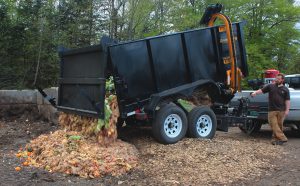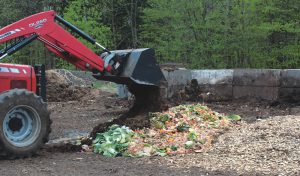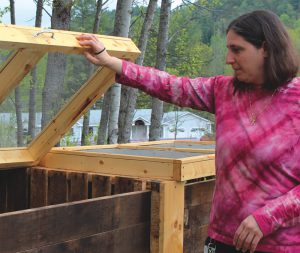Highfields Center for Composting, the Northeast Kingdom Solid Waste Management District, Kingdom View Compost and Wise Worm Compost are collaborating to service food waste generators.
Nate Clark
BioCycle July 2013, Vol. 54, No. 7, p. 38
The state of Vermont mandated the “universal recycling of solid waste” with the passage of Act 148 in June 2012, including required organics recycling for all municipalities by 2020. As a result, solid waste officials in Vermont have to figure out strategies for diverting food waste. A reality to implementing disposal alternatives is the fact that according to the 2010 U.S. Census, about 61 percent of Vermonters live in rural areas, creating challenges with the centralized approaches to collection, hauling, and processing of organic materials.
But what about viewing this “challenge” from a different vantage point? If a centralized composting facility is not feasible due to lack of population density, perhaps smaller, decentralized composting programs developed and tailored to specific regions across the state are. This is exactly the idea behind Close the Loop, a program created by the Highfields Center for Composting in Hardwick, Vermont.

A 10-cy trailer with a cart lifter is used to collect commercial and institutional organics in the Northeast Kingdom. It can hold about 5 tons of food waste, and is pulled by a one-ton heavy-duty pick-up truck.
The Highfields Center for Composting (Highfields) is a nonprofit established in 1999 to conduct research and provide technical assistance on composting and its role in promoting soil health, providing a valuable fertilizer, and strengthening food systems. Among a number of services Highfields provides to the composting world, its Close the Loop (CTL) program is perhaps most pertinent with regard to compliance with Act 148. Highfields’ CTL staff serve as community composting consultants to work with facilities and projects, schools, businesses, haulers and municipalities. ”We are available to help at any level, meeting the unique needs of a program,” explains Noah Fishman, CTL program manager. “This includes, but is not limited to: program design, marketing, and implementation; intensive trainings for students and food service workers; technical support for composters; and providing informational materials customized with a program’s sponsors logo and information. We also offer food waste collection from commercial and institutional generators.” The CTL staff is currently working in three regions of Vermont, including the Northeast Kingdom, St. Albans and Lamoille Valley.
Northeast Kingdom Program
The Northeast Kingdom in the northeast corner of Vermont encompasses 55 towns and unincorporated areas, with a land area of 2,027 square miles. It includes Essex, Orleans and Caledonia counties (total pop. 62,438). CTL Northeast Kingdom (CTL NEK) is a partnership between Highfields, the Northeast Kingdom Waste Management District (NEKWMD), local composters and area businesses. Highfields and NEKWMD have joined forces to create a compost hauling service for the NEK. Food waste generators are provided 32- or 48-gallon totes with lids and wheels for food scrap storage that are collected once a week. All types of pre and postconsumer food waste, as well as approved paper and cellulose products such as bagasse (sugarcane by-product) plates and 100 percent recycled paper towels or napkins.
Collected organics are brought to Tamarlane Farm in Lyndonville, owned and operated by Eric Paris and his family. CTL staff has worked with Paris to develop the composting program. The certified organic dairy farm has been in Paris’ family since 1956. He has lived on the farm since birth, and currently operates it with his wife Cathy, their son and son-in-law. Paris began composting on the farm in 2004 for two primary reasons. First was the family’s purchase of a former ice cream shop in the winter of 2003-2004, which is now the Lyndon Freighthouse restaurant in Lyndonville, which is managed by Paris’ daughter, Bonnie. “In May 2004, I was carrying a heavy bag of trash from the restaurant to the dumpster,” recalls Paris. “After examining the contents, I realized the majority of the waste was food scraps. So I took the bag home and built a windrow using the food scraps and cow manure. I turned the windrow periodically, when it had become compost, I was satisfied with the results.”
This led to the second reason to start composting. “I realized the potential for diverting food waste from our restaurant and creating a finished product that I could use as fertilizer for our organic agricultural operation,” he adds. “Much more needed to be done in the way of nutrient retention and returning these nutrients to the land where they belong, and diverting them from the landfills.” His decision to begin a composting operation on the Tamarlane Farm property also intrigued others as well, including Tom Gilbert, who until recently was Executive Director of Highfields. Gilbert contacted Paris about expanding the composting operation to accept food waste from surrounding institutions and businesses. Working with Paul Tomasi, director of the NEKWMD, the three began to hatch the idea for what is now Kingdom View Compost, a subsidiary of Tamarlane Farm.
Today, there are 13 food waste generators in the CTL NEK collection and composting program. Generators of the organics include schools, like the Lyndon Town School and Lyndon Institute, businesses such as the White Market grocery stores, and institutions such as the Northeastern Vermont Regional Hospital. The White Market grocery stores are the largest contributor of organic material to Kingdom View Composting. “We receive organics from the two White Market stores in Lyndonville,” notes Paris. “Most of their separation occurs in the deli areas of both stores. They use 48-gallon totes that are stored outside near their loading docks.”
Households can drop off source separated food waste at several NEKWMD transfer stations and recycling centers, which are composted by another partner, Wise Worm Compost in Burke, Vermont. Overtime, Highfields and NEKWMD plan to service residential complexes with organics collection. CTL also has started a composting program for food waste in the neighboring Lamoille Regional Solid Waste Management District.
Collection Service
A heavy-duty one-ton pick-up truck hauling a 10 cubic yard (cy) trailer is used by CTL to collect commercial and institutional organics. A LeClerc cart lifter, designed for 2-bar carts, is mounted on the side of the trailer to pick up and empty the totes. The trailer was modified with a sludge container-style door that has a tight rubber seal. “The door is top-hinged so that when the driver lifts the chassis, the food waste comes out the back,” explains Tyler Buswell of Highfields and CTL. “There are two locking mechanisms; one applies pressure to push the door against the body of the box and the other is a piece that runs length-wise against the door to reinforce it and keep it from bowing out.” The trailer can hold about 5 tons of food waste.
CTL NEK provides free training to generators, as well as instructional posters for staff, “We Compost” stickers for their windows, and literature explaining the benefits. It also provides sawdust to put on top of the food waste in the totes, which controls odors and flies. The collection trailer is equipped with a hot water pressure washer to clean out the totes after emptying them. The washer uses about 1 gallon of water per tote. “Program implementation, including the training, is funded by grants and donations to Highfields,” explains Buswell. “We charge fees for weekly pick-up of the totes, e.g., $20/48-gallon tote if only one is set out, $15/48-gallon tote if 2 to 6 are set out, etc. Our clients are billed monthly, and the fees make the program self-sustaining. The revenue is split between CTL, the haulers and the composters.” Highfields owns the trailer and hired a subcontractor with his own one-ton truck to haul the trailer and service the generators. No separate tip fee is charged by the composters, who receive 25 percent of the total tote fee revenue for the week.
Kingdom View Compost
Kingdom View Compost receives two loads of food waste each Friday — about six to seven tons/week of organics. Both Paris and Buswell anticipate that amount increasing to 10 tons/week as soon as the latest generators to join the program start being serviced. The composting facility comprises about 2 acres on the farm. It is on a base of recycled glass, with about 1,000 cy of gravel used to create the pad. “The pad was installed with year-round food waste delivery in mind, as well as year-round composting activity,” explains Paris. “We plow the snow off the delivery and work areas in the winter months. The pad was installed with a very slight slope so that any leachate produced would be directed to our adjacent hayfield. We have never witnessed any leachate, however, which is largely due to keeping the compost mix correct and using enough absorbent material such as a high grade wood chip to keep the mix from getting too wet.”
Kingdom View has a Categorical Composting Facility Permit from the Vermont Agency of Natural Resources that must be renewed every five years. The permit allows the facility to receive 420 wet tons/year of source separated food waste. At this point, notes Paris, Kingdom View can double production and still remain within the limits of its permit. To receive the permit, Paris was required to write a letter to each adjoining landowner regarding the composting operation. In 2012, the most recent time Paris renewed the permit, he did not receive one negative comment regarding the facility, and points out that he receives nothing but support from community members. “Even in wet years, I have never had a problem with leachate or smell from the operation,” he says.
Incoming food waste is tipped on a bed of wood chips to absorb the liquid. After unloading, Paris mixes the food waste with three amendments: wood chips, certified organic cow manure, and organic silage (from his farm). The final mix contains around 33 percent food waste and 10 percent cow manure, with the remainder evenly split between wood chips and farm waste. Kingdom View Compost does not accept compostable plastic products, because the corn used to make the products often contains genetically-modified organisms or may not be certified organic. The compostable plastics also can be more cumbersome to compost, notes Buswell. Wind can blow fragments off of the windrows and they can take longer to decompose than many other feedstocks.
The material is gradually rolled into a receiving bay — a 3-sided cement structure. “Raw material is blended and rolled together into this structure so the feedstocks can meld,” explains Paris. “This process also keeps raw food waste from being introduced into the windrow. By the time this material is put into the windrow, most of the food waste is already broken down, thus reducing the presence of birds and other scavengers. It also jumpstarts the composting process.”
The mix stays in the bay for about three weeks without being turned or aerated. The following week’s delivery is put in a pile parallel to the existing one. “These piles are rolled toward each other, eventually creating one pile,” he adds. “As the material is brought out of the receiving bay and built into a window, the date and length of this addition to the windrow is recorded. From that point on, this ‘windrow within a windrow’ is monitored and tracked, along with the previously built windrows.” The rolling process, done with a front-end loader, is Paris’s method of aerating the piles.

After unloading at Kingdom View Compost, food waste is mixed with wood chips, cow manure and silage and gradually rolled into a 3-sided cement receiving bay. Material remains there for 3 weeks to jumpstart the composting process.
To meet the Northeast Organic Farmers Association of Vermont’s organic compost rules for pathogen reduction requirements, the windrows must remain at a temperature of at least 131°F for two weeks and rolled at least five times. Paris also will roll piles when he notices the temperature is decreasing in order to stimulate decomposition. He continues to roll the windrows until the heat is gone and the temperature of the product is similar or less than ambient. If space is needed for more active windrows, the finished compost is stored in a curing pile until being screened the following spring. “We usually end up with about three windrows of finished compost by the end of the summer,” he says. “The windrows of ‘working compost’ will be managed throughout the winter and finished the following summer or fall. Even though we compost year-round, since screening takes place once a year in the spring, it does take a full year for salable compost to be produced. Most of the active composting occurs in the warmer months, as cold and wet weather does slow the process but it doesn’t stop completely.”
Kingdom View uses a trommel screen brought in by a friend; screened overs are put back into the compost pile. The compost is approved for certified organic application. More than half is used on Tamarlane’s certified organic farm on its pastures and sometimes on its cropland. “The majority of our sales go to high-end gardeners and landscapers, as well as to individual families for their own gardens,” says Paris. “We also donate compost back into the community to schools and community gardens.” The Lyndon Town School and Lyndon Institute both utilize the compost in the school gardens, and as a teaching aid for students when learning about sustainable agriculture, soil health and the overall composting process (see sidebar).
The Close The Loop model and Kingdom View Compost are extraordinary examples of community sustainability, community resilience and community action in the environment. By keeping nutrients within their region, all involved with Kingdom View Compost are doing their part to bolster their food systems while diverting valuable nutrients from the landfill and building social capital within their region. And for the Paris family farm, closing the loop embodies the sustainability of their operation. “We produce milk, of course, but we also produce organic beef and vegetables for our family-owned restaurant, The Lyndon Freighthouse,” notes Paris. “The food waste from the restaurant is returned to the farm, composted and used again to produce more food, thus completing our own food cycle.”
Nate Clark is a Contributing Editor to BioCycle.











